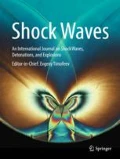Abstract
In this study, we present the results of an investigation of the propagation of cylindrical shock wave segments in converging–diverging channels. Three planar-symmetric channels were used: two formed from a pair of walls with circular wall profiles (radii 150 mm and 225 mm) and a third following a third-order-polynomial profile. In contrast to the circular walls, which are convex, the polynomial wall has both convex and concave curved sections. A plane shock was generated using a conventional shock tube after which a 165-mm-radius cylindrical shock segment was formed by allowing the plane shock to pass through a circular arc-shaped annular space. This shock was then allowed to propagate in the converging–diverging channel formed from the two walls described earlier. The resulting shock evolution was captured using a z-type schlieren technique. Whitham’s geometric shock dynamics (GSD) and computational fluid dynamics (CFD) were used to create numerical models of the shock’s propagation. Comparisons between the three methods (experiment, CFD, and GSD) were made. In general, qualitative agreements between the three methods were observed (with slight discrepancies). For example, a shock with an initial Mach number of 1.37 interacting with a 150-mm-radius wall exhibited high curvature at the shock’s central position towards the channel’s throat (as observed in experiment), an observation which was not replicated by either CFD or GSD. Quantitatively, there were significant differences (before accounting for experimental errors). On comparing centreline shock Mach numbers between the three methods, CFD results were closer to experimental results, while GSD results were consistently higher but within the experimental data error bounds. However, the general trend was the same in all three, i.e., the shock strengthens and weakens in the converging and diverging sections, respectively.




















Similar content being viewed by others
Abbreviations
- \((\alpha , \beta )\) :
-
Coordinates on a curvilinear coordinate system
- (x, y):
-
Coordinates on a Cartesian plane
- \(\epsilon _{\mathrm {M}}, \epsilon _{\mathrm {P}}\) :
-
Error in shock Mach number and position, respectively
- \(\eta (M)\) :
-
Modification factor of Whitham’s theory
- \(\gamma \) :
-
Ratio of specific heat capacities
- \(\theta \) :
-
Shock orientation
- \(\mathbf {n}_{i}\) :
-
Normal on the shock front
- A :
-
Channel cross-sectional area
- \(a_0\) :
-
Speed of sound ahead of the shock
- \(f_1, f_2\) :
-
Property value (e.g., density) for a fine and course mesh (relatively), respectively
- M :
-
Shock Mach number
- \(M_{\mathrm {0}}\) :
-
Initial shock Mach number
- p :
-
Position of probe point
- r :
-
Shock radius, or ratio between course and fine mesh sizes
- t :
-
Time
- u, v :
-
x and y component of velocity
- GCI:
-
Grid Convergence Index
References
Edwards, D., Fearnley, P., Nettleton, M.: Shock diffraction in channels with 90\(^\circ \) bends. J. Fluid Mech. 132, 257–270 (1983). https://doi.org/10.1017/S0022112083001597
Chester, W.: The quasi-cylindrical shock tube. Lond. Edinb. Dublin Philos. Mag. J. Sci. 45(371), 1293–1301 (1954). https://doi.org/10.1080/14786441208561138
Chisnell, R.: The motion of a shock wave in a channel, with applications to cylindrical and spherical shock waves. J. Fluid Mech. 2(3), 286–298 (1957). https://doi.org/10.1017/S0022112057000130
Whitham, G.: A new approach to problems of shock dynamics Part I. Two-dimensional problems. J. Fluid Mech. 2(2), 145–171 (1957). https://doi.org/10.1017/S002211205700004X
Skews, B.: The shape of a diffracting shock wave. J. Fluid Mech. 29(2), 297–304 (1967). https://doi.org/10.1017/S0022112067000825
Bryson, A.E., Gross, R.W.F.: Diffracting of strong shocks by cones, cylinders, and spheres. J. Fluid Mech. 10(1), 1–16 (1961). https://doi.org/10.1017/S0022112061000019
Milton, B.E.: Mach reflection using ray shock theory. AIAA J. 13, 1531–1533 (1975). https://doi.org/10.2514/3.60566
Itoh, S., Okazaki, N., Itaya, M.: On the transition between regular and Mach reflection in truly non-stationary flows. J. Fluid Mech. 108, 383–400 (1981). https://doi.org/10.1017/S0022112081002176
Henshaw, W.D., Smyth, N.F., Schwendeman, D.W.: Numerical shock propagation using geometrical shock dynamics. J. Fluid Mech. 171, 519–545 (1986). https://doi.org/10.1017/S0022112086001568
Guderley, G.: Starke kugelige und zylindrische Verdichtungsstösse in de Nähe des Kugelmittelpunktes bzw de Zylinderachse. Luftfahrtforschung 19, 128–129 (1942)
Roache, P.J.: Perspective: A new method for uniform reporting of grid independence studies. J. Fluids Eng. 116(3), 405–413 (1994). https://doi.org/10.1115/1.2910291
Lacovig, L.: The construction and calibration of a shock tube for large scale diffraction studies, MSc Dissertation. University of the Witwatersrand (2011)
Skews, B., Gray, B., Paton, R.: Experimental production of two-dimensional shock waves of arbitrary profile. Shock Waves 25(1), 1–15 (2015). https://doi.org/10.1007/s00193-014-0541-4
Shirouzu, M., Glass, I.I.: An assessment of recent results on pseudo-stationary oblique shock wave reflections. UTIAS Report No. 264. University of Toronto, Institute of Aerospace Studies (1982)
Funding
Funding was provided by the South African National Research Foundation.
Author information
Authors and Affiliations
Corresponding author
Additional information
Communicated by M. Brouillette and A. Higgins.
Publisher's Note
Springer Nature remains neutral with regard to jurisdictional claims in published maps and institutional affiliations.
Rights and permissions
About this article
Cite this article
Ndebele, B.B., Skews, B.W. The interaction of a cylindrical shock wave segment with a converging–diverging duct. Shock Waves 29, 817–831 (2019). https://doi.org/10.1007/s00193-018-00888-7
Received:
Revised:
Accepted:
Published:
Issue Date:
DOI: https://doi.org/10.1007/s00193-018-00888-7




